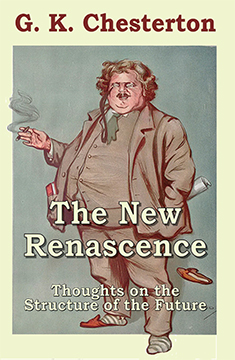
The New Renascence
Thoughts on the Structure of the Future
by G. K. Chesterton
new material in this book copyright © 2020
Buy or preview the book |
A New Book by Chesterton
This work by G. K. Chesterton was published in 1920 and 1921 as a series of twelve articles in Vanity Fair magazine. Though it is an important statement of Chesterton’s ideas about the good society, this is the first time it has appeared in book form.
In Chesterton’s witty and paradoxical style, the book criticizes the uniformity and lack of spontaneity and joy in modern society. It begins by contrasting modern sports, which have strict rules, with pre-modern sports, which people invented spontaneously. It goes on through a number of examples, such as the uniformity of London rowhouses, which do not express the character of their owner.
It concludes by advocating distributism, which calls for distributing ownership of small property as widely as possible. For example, everyone should have their own garden to work on as they please.
In a way, distributism has the same goal as socialism: it aims at removing the stranglehold that large scale property has over ordinary people’s lives. But its method is the opposite: to give everyone property rather than to nationalize property. Chesterton criticizes the drabness and uniformity that socialism imposes and celebrates the joyfulness and diversity that would result if people managed their own small property.
Gilbert Keith Chesterton (1874 – 1936) was one of the best known and best loved British writers of the early twentieth century. He is famous for his books on society and religion, such as Heretics and Orthodoxy, for his novels, such as The Man Who Was Thursday, for his Father Brown series of detective stories, and for his many articles and essays.


